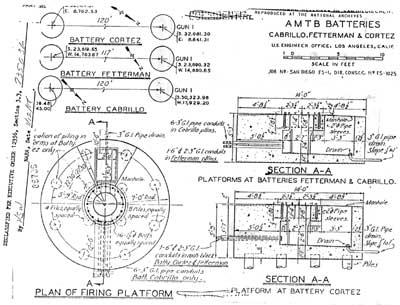|
CABRILLO
The Guns of San Diego Historic Resource Study |

|
CHAPTER 7:
WORLD WAR II AND AFTER, 1941-1948 (continued)
E. Batteries Cabrillo, Fetterman (II), and Cortez
By the fall of 1942, the Army decided to install 90mm anti-motor torpedo boat (AMTB) batteries in the harbor defenses. Each battery consisted of two fixed guns and two mobile guns. (The mobile guns were kept in storage until an emergency occurred.) The mission of these batteries was to attack enemy motor torpedo boats, to defend against enemy landings, to assist against enemy air (the 33rd Coast Artillery (AA), which was not in the Harbor Defenses of San Diego, was primarily responsible against enemy air attacks), and to attack enemy submarines within range. After considerable discussion, the Office of the Chief of Engineers decided that San Diego would receive three four-gun 90mm batteries: Battery Cabrillo at Point Loma, which meant the inactivation of Battery Point Loma's 155mm guns; Battery Fetterman at Ballast Point; and Battery Cortez on the Silver Strand. Two guns would be emplaced and two mobile.
All three batteries were completed in August 1943 and the six guns were mounted in September. The District Engineer supervised construction of concrete emplacements. The post engineer installed the electricity and the troops performed the necessary labor. The cost of each battery was approximately $20,000.
Battery Cabrillo
| Guns | Caliber | Model | Ser. No. | Manufacturer |
| 1 | 90mm | M1-1943 | 3031 | Wheland Company |
| 2 | 90mm | M1-1943 | 15327 | General Motors, Chevrolet Division |
| Carriages | Type | Model | Ser. No. | Manufacturer |
| 1 | M-3 | PA1943ABO | T3-92 | General Motors, Fisher Body |
| 2 | M-3 | PA1943ABO | T3-201 | General Motors, Fisher Body |
Battery Fetterman
| Guns | Caliber | Model | Ser. No. | Manufacturer |
| 1 | 90mm | M1-1943 | 15329 | General Motors, Chevrolet |
| 2 | 90mm | M1-1943 | 10806 | Watervliet Arsenal |
| Carriages | Type | Model | Ser. No. | Manufacturer |
| 1 | M-3 | PA1943ABO | T3-160 | General Motors, Fisher Body |
| 2 | M-3 | PA1943ABO | T3-235 | General Motors, Fisher Body |
Battery Cortez
| Guns | Caliber | Model | Ser. No. | Manufacturer |
| 1 | 90mm | M1-1943 | 15311 | General Motors, Chevrolet |
| 2 | 90mm | M1-1943 | 14861 | General Motors, Chevrolet |
| Carriages | Type | Model | Ser. No. | Manufacturer |
| 1 | M-3 | PA1943ABO | T3-205 | General Motors, Fisher |
| 2 | M-3 | PA1943ABO | T3-156 | General Motors, Fisher [8] |
F. Additional Defense Measures
To supplement the new 90mm batteries, the Army installed three batteries of 37mm antiaircraft weapons, sited primarily to protect the harbor entrance against motor torpedo boats. Each battery consisted of two 37mm guns with two .50 caliber machine guns mounted on each 37mm carriage: Battery Cliff, immediately above the new lighthouse; Battery Bluff, at Billy Goat Point; and Battery Channel, also on the east side of Fort Rosecrans on Ballast Point adjacent to the U.S. Coast Guard station. Battery Bluff is within Cabrillo National Monument and is recorded as Historic Structure 9. In 1944, the Western Defense Command announced that 40mm antiaircraft guns would replace all 37mm weapons in the command. Although sixteen 40mm guns were authorized, as far as it may be determined the war ended before any of them reached San Diego. [9]

|
| AMTB (Anti-Motor Torpedo Boat), Battery Bluff. Position currently located at Cabrillo National Monument. This battery consisted of two water-cooled 50 caliber machine guns and one 37mm cannon. Three men on right can be seen feeding belts and clips to weapons. Photo courtesy of San Diego Military Heritage Society. |
In January 1943 the Los Angeles District Engineer learned that the cast armor shields for the guns of 6-inch Battery Humphreys were en route to Fort Rosecrans. Each shield weighed forty-two tons. Ironically, the shields for the 8-inch guns of Battery Strong still had not been installed as late as July 1945. The question remains as to whether they ever did arrive. [10]
Early in 1942, Col. Ottosen complained that the harbor defense command post was too small for efficient operations, especially for the army and navy radios which had to compete with other activities going on in the same room. Also, the structure needed latrines. He said that the signal station in the old lighthouse was reasonably satisfactory, but not as a permanent installation. As a result of his letter, a radio room was added to the HDCP and a concrete dugout signal station was constructed south of the lighthouse. Another enlargement of the command post occurred in 1943 after Gen. DeWitt, commanding the Western Defense Command, paid a visit to San Diego. At the HDCP he was unhappy in that there was no room wherein senior Army and Navy officers could hold private conferences. The Chief of Engineers promptly made $11,600 available for the additional bombproof room. [11]
Coastal radar, SCR296A, was added to the harbor defenses early in 1943. The first three sets were erected near Battery Strong in north Fort Rosecrans, near the new lighthouse at Point Loma, and near the Mexican border. Before the year was out, three additional sets were authorized: La Jolla, Fort Rosecrans, and Fort Emory. [12]
| <<< Previous | <<< Contents >>> | Next >>> |
cabr/guns-san-diego/hrs7b.htm
Last Updated: 19-Jan-2005
